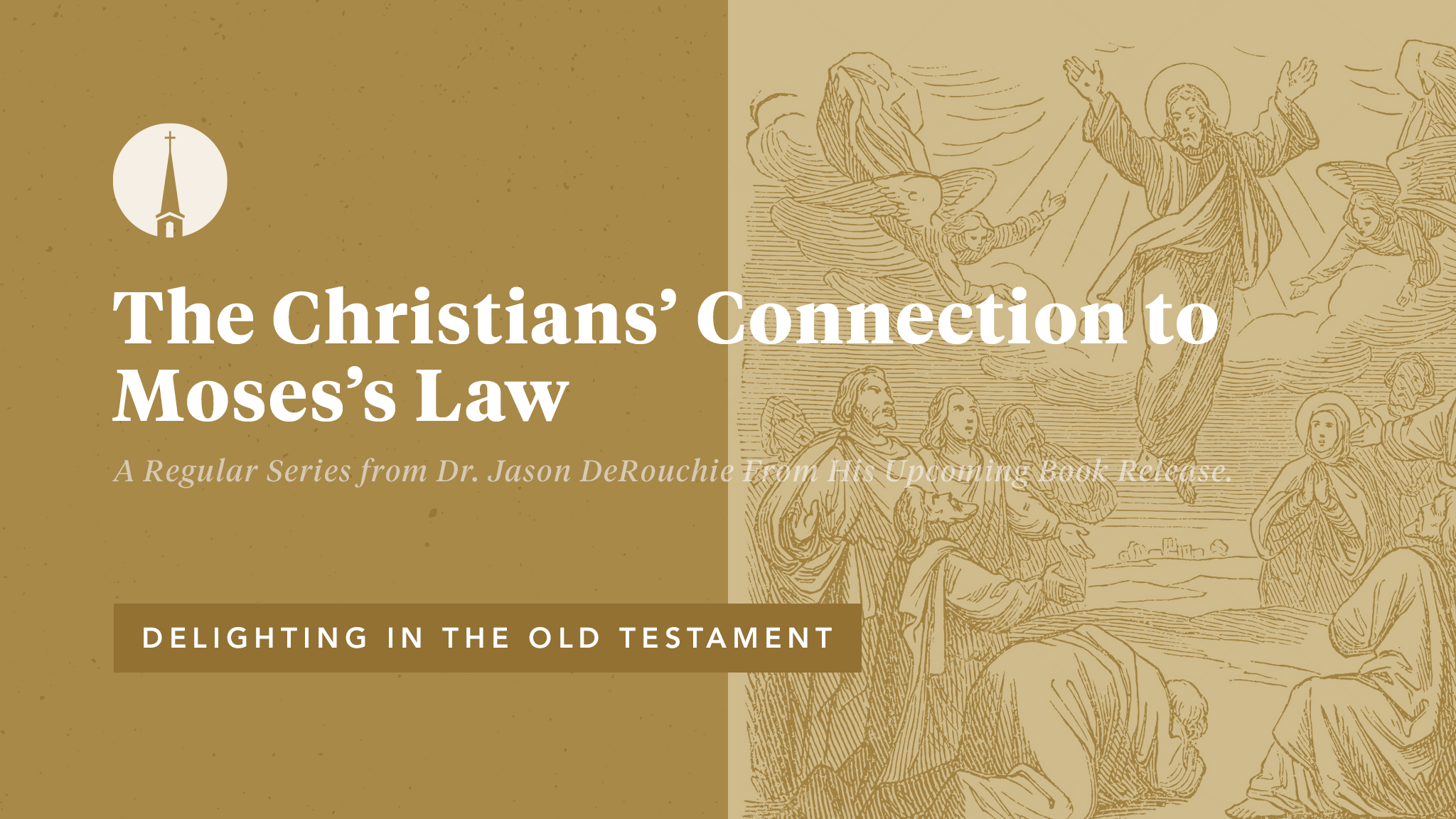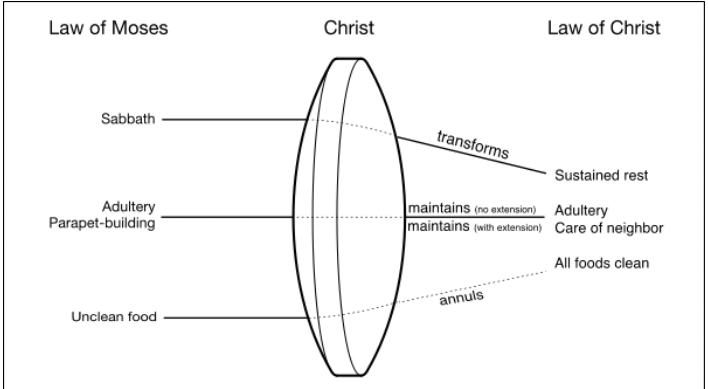
“Not under Law” (Rom 6:14):
How does the OT law apply to Christians when so much has changed with Christ’s coming, not least of which is that we are part of the new covenant and not the old? With a simple alliteration, Brian Rosner has captured well three principles that clarify the Christian’s relationship to the Mosaic law. The biblical authors repudiate the old Mosaic law-covenant, replace Moses’s law with the law of Christ, and then reappropriate the law of Moses through Christ.
1. Biblical Authors Repudiate the Mosaic Law-Covenant
By God’s purposes, the Mosaic law multiplied transgression (Rom 5:20; Gal 3:19), exposed sin (Rom 3:20), and brought wrath (4:15) to show that “one is justified by faith apart from works of the law” (3:28). Christians repudiate the Mosaic law-covenant, “for Christ is the end of the law for righteousness to everyone who believes” (10:4). “The law was our guardian until Christ came, in order that we might be justified by faith. But now that faith has come, we are no longer under a guardian” (Gal 3:24–25). Thus, as the author of Hebrews declared: “In speaking of a new covenant, he makes the first one obsolete. And what is becoming obsolete and growing old is ready to vanish away” (Heb 8:13). “The law made nothing perfect” (7:19), but in Christ we find a “better hope” (7:19), a “better covenant” (7:22), “better promises” (8:6), “better sacrifices” (9:23), “better possession” (10:34), a “better country” (11:16), a “better life” (11:35), and a “better word” (12:24).
2. Biblical Authors Replace Moses’s Law with the Law of Christ
Moses knew that Israel’s system of worship was merely symbolic, suggesting that it would become obsolete when shadow moved to substance (Exod 25:9, 40; Zech 3:8–9; 6:12–13). Moses also affirmed the need for a better covenant––one in which Yahweh would accomplish for Israel what he did not accomplish with Moses (Deut 29:4; 30:6, 8). Furthermore, the prophets longed for the day when God would teach every member of the blood-bought community (Isa 54:13), write his law on their hearts (Jer 31:33), and cause them to walk in his statutes (Ezek 36:27). All these hopes have been realized through Christ’s person and work (John 6:44–45; Rom 2:14–15; 8:3–4; Col 2:16–17).
As Christians, our “release from the law” (Rom 7:6; cf. 6:14) in part means that the Mosaic law is no longer the direct authority and immediate judge of the conduct of God’s people. The age of the Mosaic law-covenant has come to an end in Christ (10:4), so the law itself has ceased from having a central and determinative role among God’s people (2 Cor 3:4–18; Gal 3:15–4:7). As a written legal code, not one of the 613 stipulations in the Mosaic law-covenant is directly binding on Christians. Instead, we are bound by the law of Christ (1 Cor 9:20–21; Gal 6:2), which is summarized in the call to love our neighbor and which James refers to as the perfect law (Jas 1:25).
3. Biblical Authors Reappropriate Moses’s Law through Christ
While the NT authors highlight the Mosaic law’s condemning nature and stress that believers are now under the law of Christ, they also apply OT laws to Christians based on Christ’s justifying and sanctifying work (e.g., Eph 6:2–3; 1 Tim 5:17–18; 1 Pet 1:15–16). As an illustration, in Romans 13:8–10, Paul urges believers, in view of God’s mercies shown in Christ (Rom 12:1; cf. chaps. 1–11), to fulfill the law by loving others. In this passage, Paul cites four commands associated with the Ten Commandments that focus directly on valuing God’s image in others. Yet by adding “any other commandment,” he shows that love fulfills all Moses’s directives, even those beyond the Decalogue.
Although Moses’s law does not directly bind Christians legally, we do not throw out the law itself. As Moses himself foresaw, God’s people would turn and “obey the voice of the Lord and keep all his commandments” in the day of heart circumcision (Deut 30:8). Along with repudiating the old covenant and replacing its law with the law of Christ, then, Christians must reappropriate Moses’s instruction (1) as a testimony to God’s character and values, (2) as prophecy that anticipates the gospel of Jesus, and (3) as wisdom intended to guide new-covenant saints in our pursuit of God.
Moses’s Law Reveals God’s Character and Values
The Mosaic law expresses God’s character. Yahweh asserted, “You shall … be holy, for I am holy” (Lev 19:2), and the way Israel would fulfill this charge was by heeding God’s words (Exod 19:5–6; Num 15:40). Paul stressed that the law is “the embodiment of knowledge and truth” (Rom 2:20) and that “the commandment is holy, righteous, and good” (7:12). Peter, too, asserted, “As he who called you is holy, you also be holy in all your conduct, since it is written, ‘You shall be holy, for I am holy’” (1 Pet 1:15–16). Moses’s law signals what Yahweh values and hates, what he delights in and detests. Christians learn about the character of God through Moses’s law, and this in turn can clarify what it means to image him faithfully (Gen 1:26–28).
Moses’s Law Anticipates the Gospel concerning Christ
Jesus stressed that he came not “to abolish the Law and the Prophets” but “to fulfill them” (Matt 5:17). By “fulfill,” he meant in part that he supplies the end-times actualization of all the OT predicted. Thus, “all the Prophets and the Law prophesied until John” (Matt 11:13), and the very “gospel of God … concerning his Son” was “promised beforehand through his prophets in the holy Scriptures” (Rom 1:1–3). Jesus stood as the goal and end of the OT’s hopes, pictures, and patterns.
As the last Adam (1 Cor 15:45), the representative of Israel (Isa 49:1–6; Matt 21:9; Luke 1:32–33), the true Passover lamb (John 1:29; 1 Cor 5:7), and the true temple (John 2:21), Christ is the substance of all old-covenant shadows (Col 1:16–17; Heb 8:5; 10:1). His role as teacher and covenant mediator also fulfills Moses’s own hopes for a covenant-mediating “prophet” like him––one who would know God face to face, who would perform great wonders, and to whom people would listen (Deut 18:15–19; 34:10–12; cf. Luke 7:16; Acts 3:22–26).
Moses’s Law Guides Christians in Love and Wise Living
The “law of Christ” that we live out (Isa 42:4; 1 Cor 9:21) is the law of love as fulfilled and taught by Jesus, which is the end-times realization of Moses’s law. Jesus said that “all the Law and the Prophets” depend on the commands to love God and neighbor (Matt 22:37–40). Paul added that “the whole law is fulfilled in one word: ‘You shall love your neighbor as yourself’” (Gal 5:14). Significantly, every commandment, not just a “moral” subset of the law, is fulfilled in the call to love (Rom 13:8–10).
In both the old and new covenants, then, love is what God’s people are to do. All the other commandments simply clarify how to do it. From this perspective, while the Mosaic law does not directly or immediately guide Christians, it does show us how deeply and pervasively we should love God and neighbor.
Four Ways Christ Fulfills Moses’s Law
As discussed in the previous post, Jesus is the lens that clarifies how to rightly appropriate the law of Moses, and he alone supplies the power to obey it. When Moses’s instruction is viewed through this lens (see fig. 1), some laws appear unchanged, whereas others hit the lens and get “bent” in various ways. Jesus’s coming maintains (with and without extension), transforms, and annuls various laws.

Figure 1. The Law’s Fulfillment through the Lens of Christ
Another way to grasp how Christians should relate to OT law is to visualize two riverbanks separated at varying distances by water (see fig. 2). The two sides symbolize the old- and new-covenant laws, and Jesus is the “bridge” over which we must move from one side to the other. Our distance from the Mosaic legislation changes depending on the nature of the law in question. Thus, some laws (e.g., prohibitions against murder and adultery) are so similar that the distance seems almost nonexistent, but other laws (e.g., relating to food laws and the Sabbath) disclose substantial distance.

Figure 2. The Law’s Fulfillment over the Bridge of Christ
Summary
Jesus and the NT authors repudiate the Mosaic law-covenant, replace Moses’s law with the law of Christ, and reappropriate Moses’s law through Christ. They do this to give us glimpses of God’s character and to guide believers in wisdom and love. None of Moses’s law is directly binding on God’s people today in a legal or regulatory way (Rom 7:4; Gal 3:24–25), but it continues to impact us through Christ in both revelatory and pedagogical ways. Christ is like a lens, and through him (and his NT revelation) we can discern whether he maintains, transforms, or annuls any given law.
¹Brian S. Rosner, Paul and the Law: Keeping the Commandments of God, NSBT 31 (Downers Grove, IL: InterVarsity Press, 2013), 208–9, 217–22.
²Tom Wells and Fred G. Zaspel, New Covenant Theology: Description, Definition, Defense (Frederick, MD: New Covenant Media, 2002), 115.
This blog series summarizes Jason S. DeRouchie’s forthcoming book, Delighting in the Old Testament: Through Christ and for Christ (Wheaton, IL: Crossway, 2024). You can pre-order your copy here.

